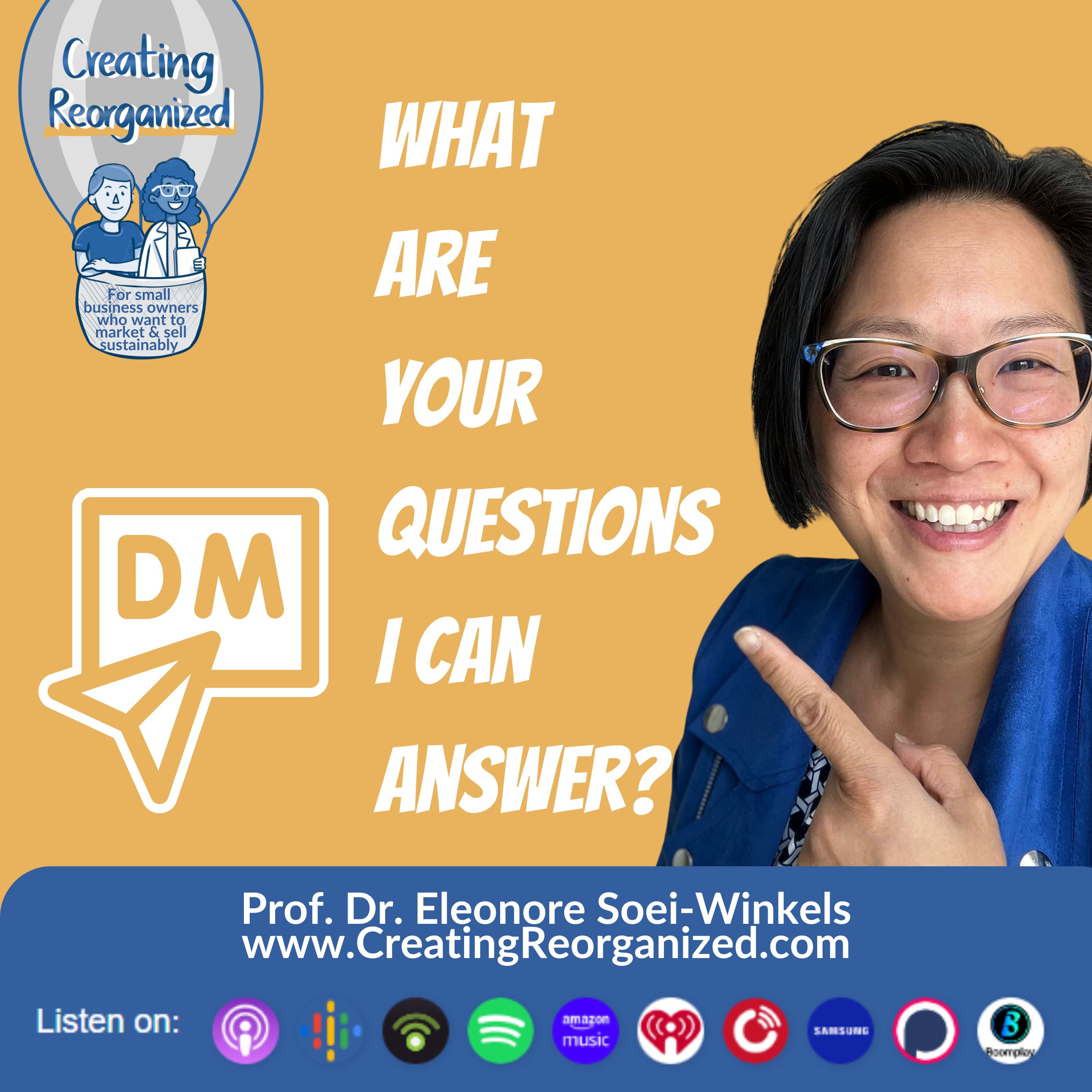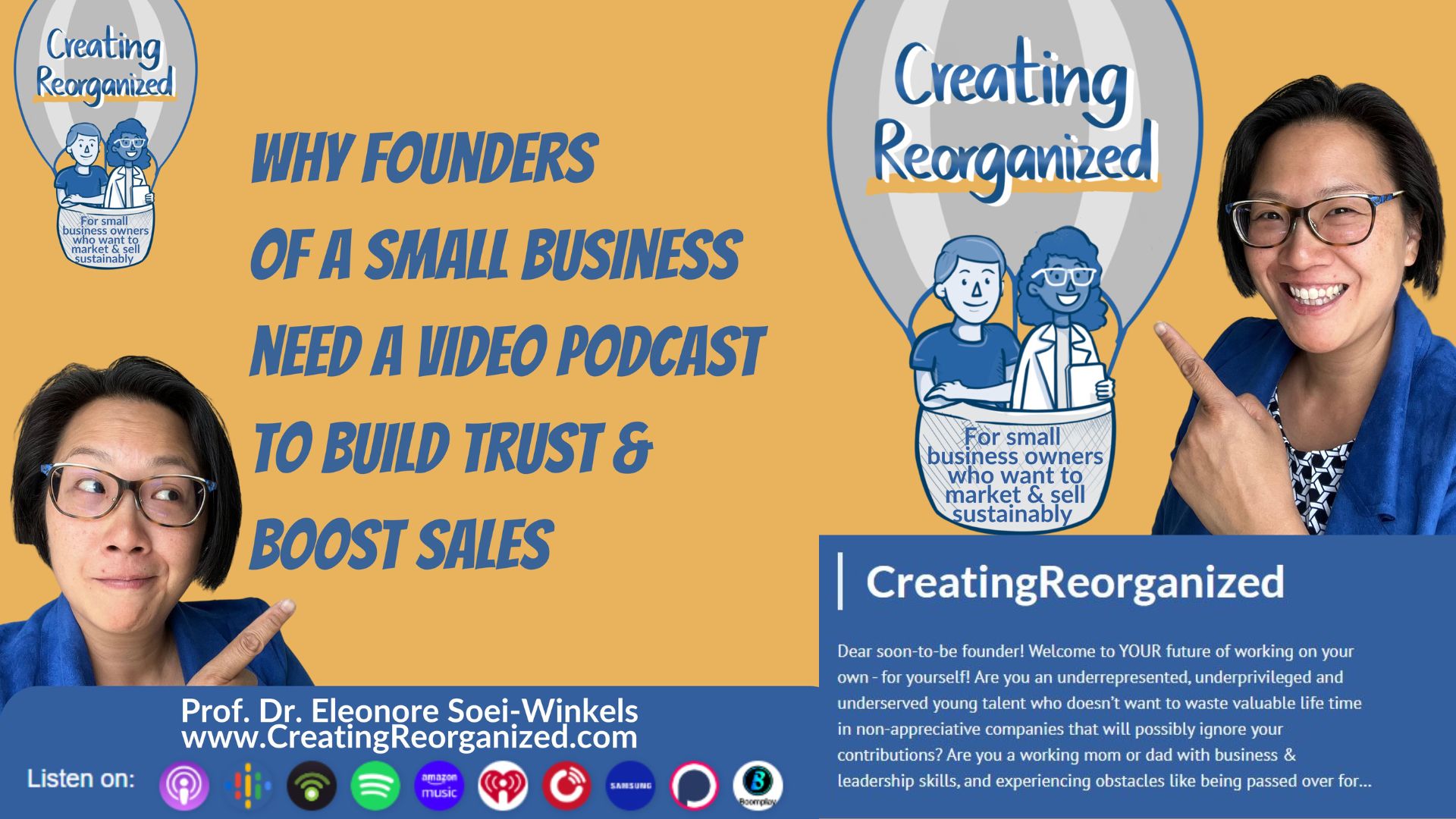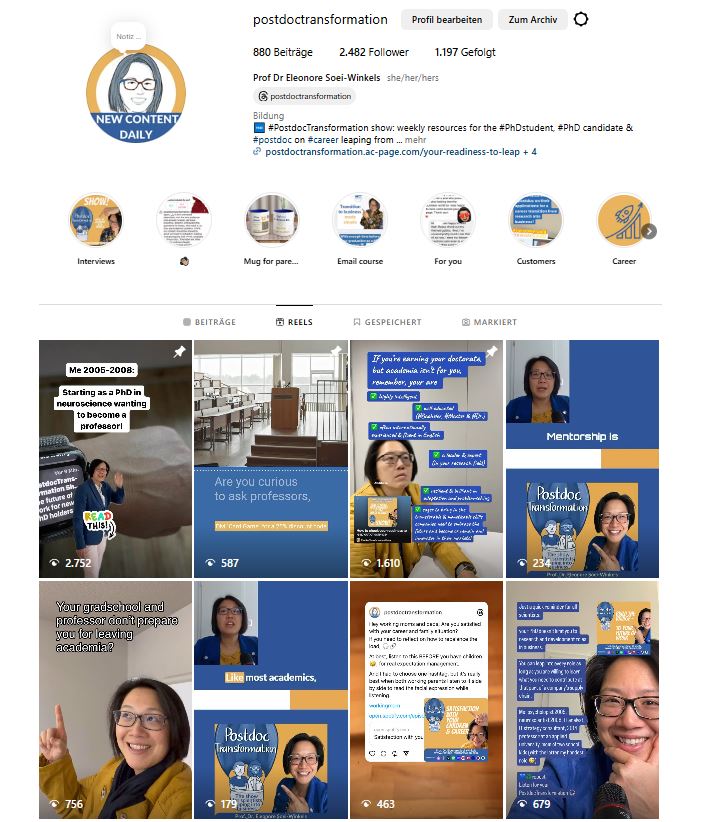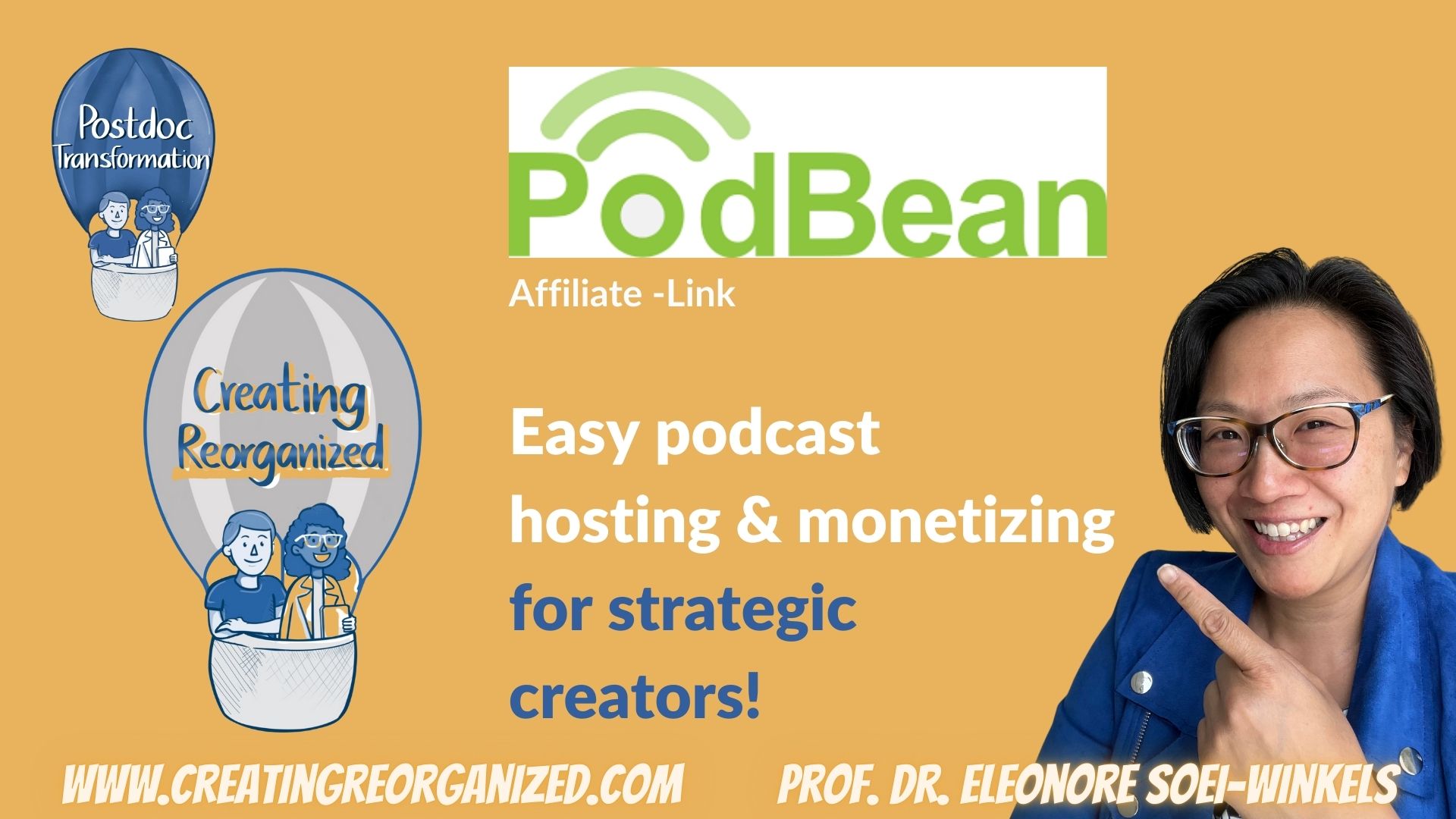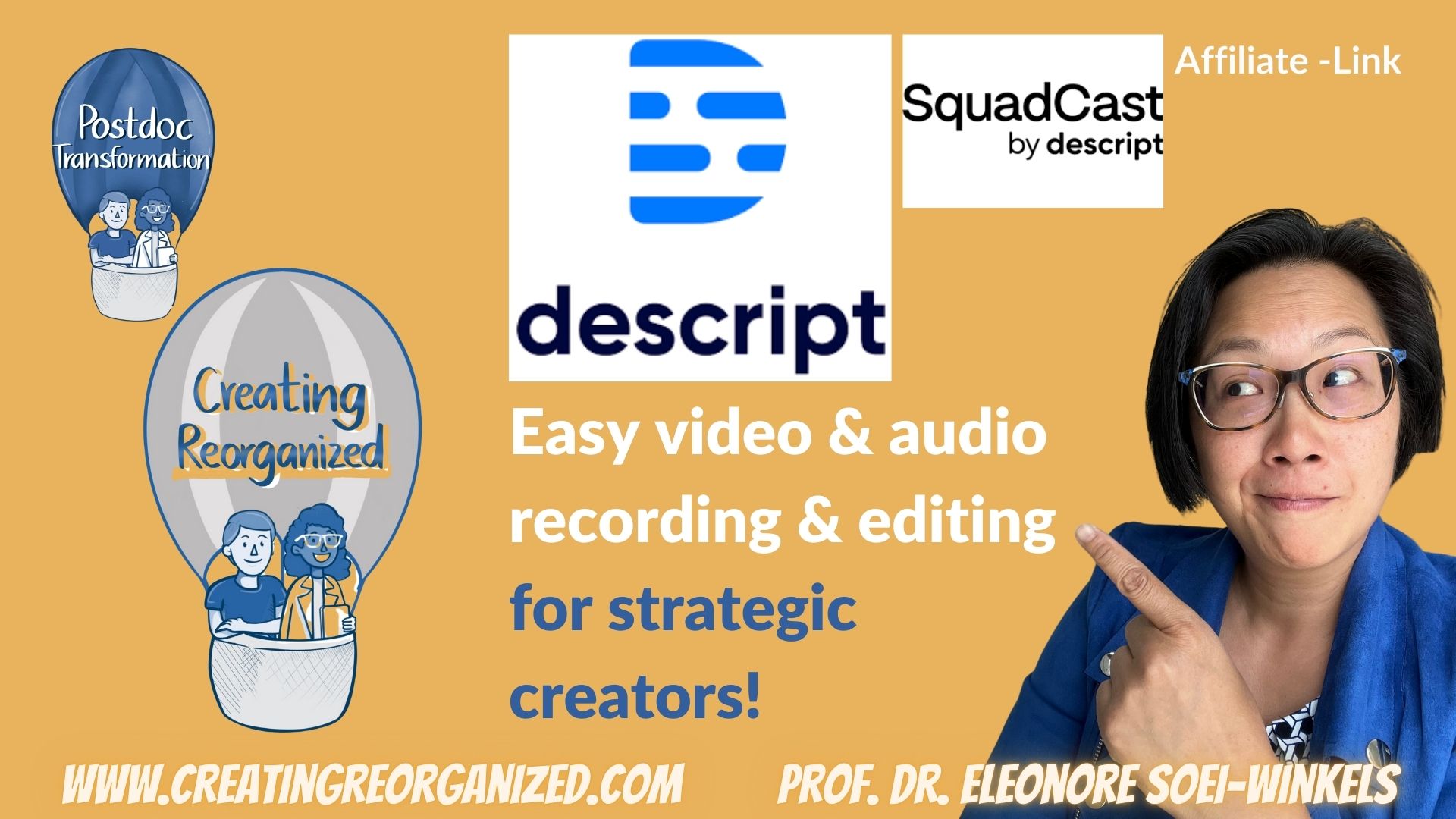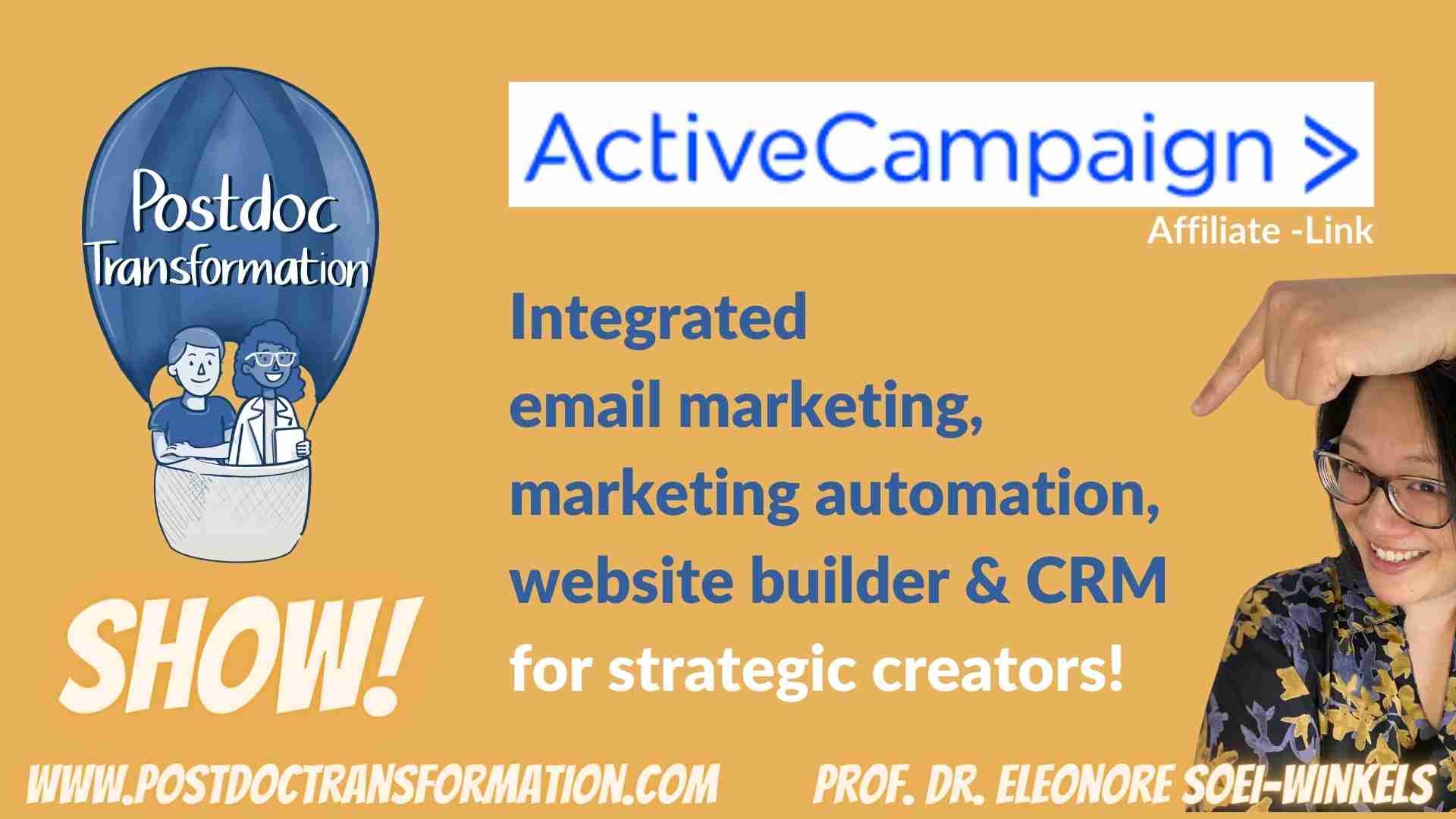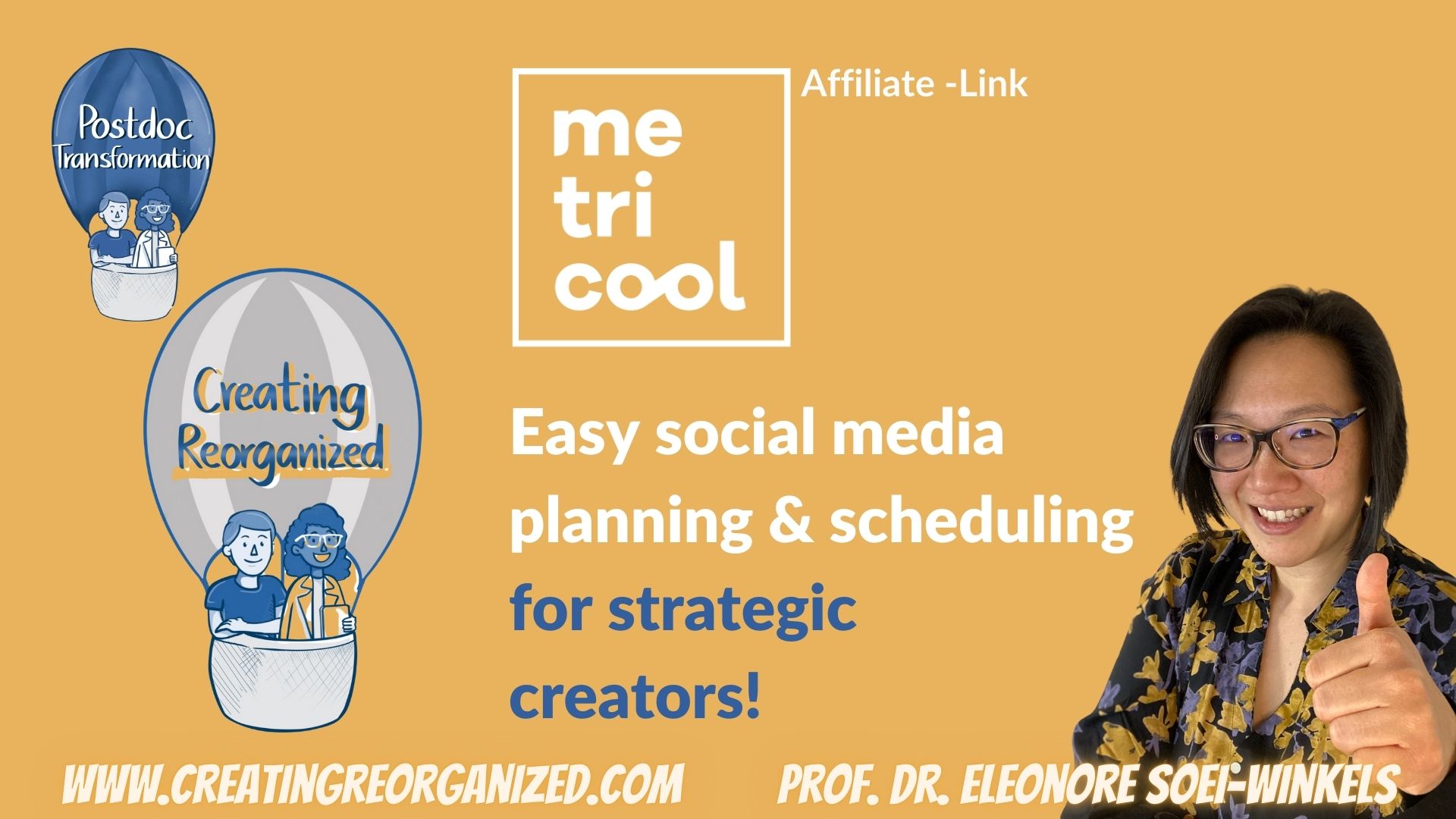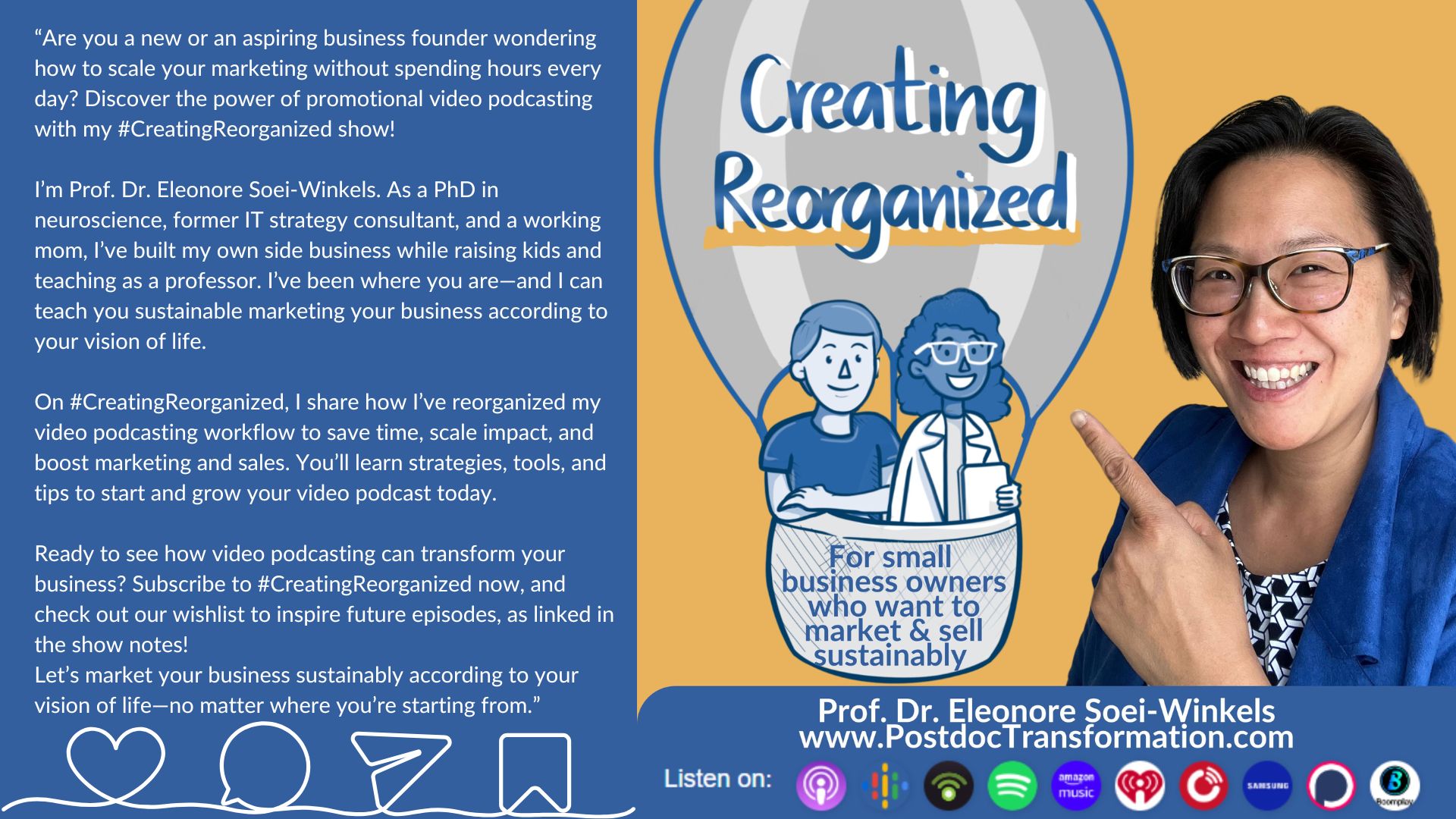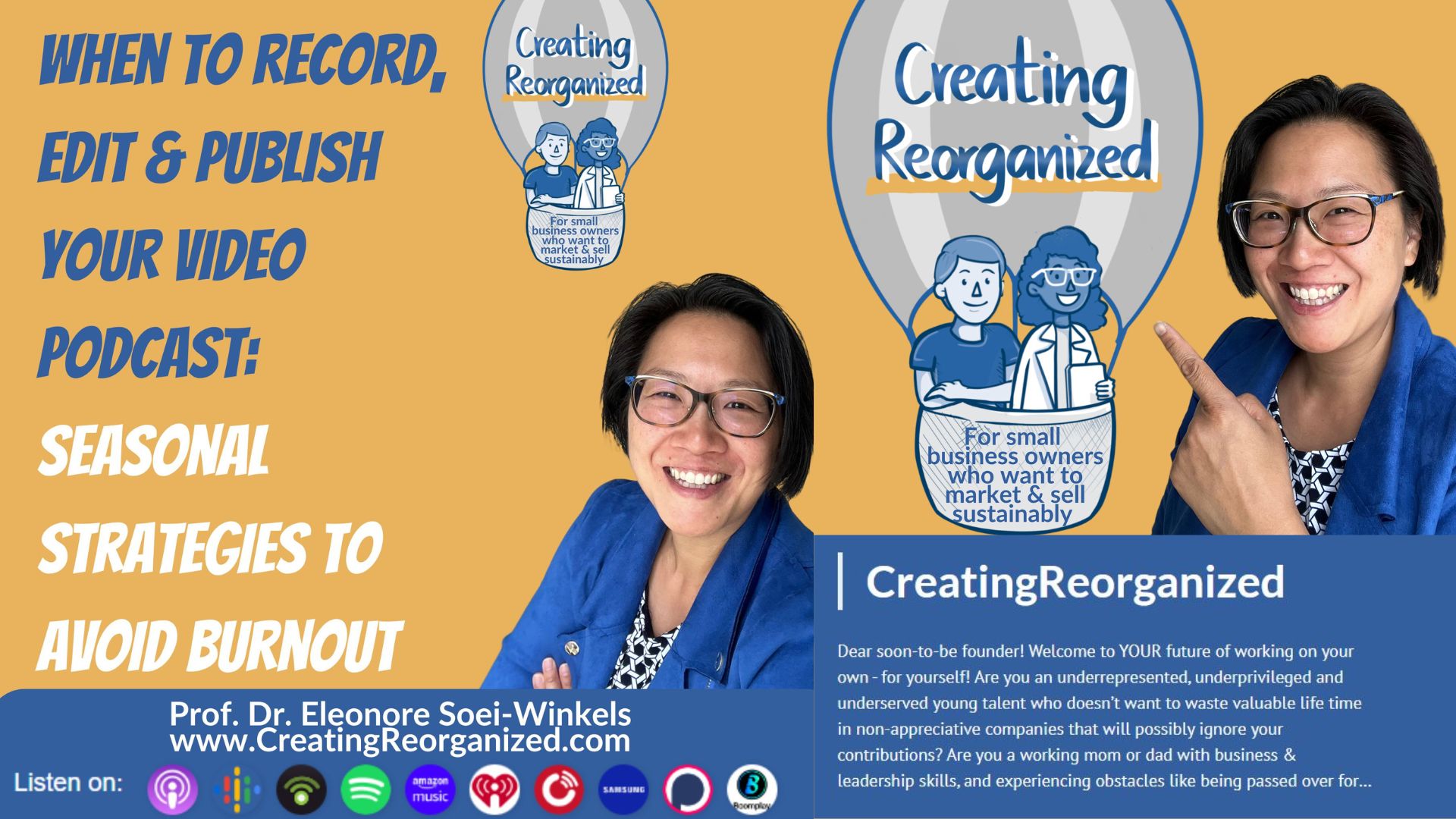
When to record, edit and publish your video podcast seasonal strategies for the small business owners to avoid burnout,
CreatingReorganized show
In this episode of the #CreatingReorganized show, you learn seasonal strategies for recording, editing, and publishing your video podcast as a small business owner.
Prof. Dr. Eleonore Soei-Winkels shares her insights and practical tips on how to align video podcast content with seasonal trends to maximize engagement and sales. She teaches you the importance of timing, batch recording, and using various tools like Podbean, Descript, Typeform, Metricool, and ActiveCampaign for workflow efficiency.
The episode aims to help the founder streamline the production processes, avoid burnout (or "podfade"), and leverage video podcasting as an effective marketing tool across years to drive sales. Additionally, Eleonore offers a business podcasting internship opportunity for interested listeners.
The episode concludes with encouragement for viewers to prioritize their mental health and business goals over rigid content creation schedules.
If you are a new or aspiring founder of your small business and have no time to waste, or really struggle to do your social media marketing, you will enjoy our #CreatingReorganized show!
In my day job as a psychology professor I teach my bachelor and master students in real life, how to reorganize processes in a goal-directed and future-proof way in companies. That’s what I had done for a living as a former IT strategy consultant.
For my own career coaching business on the side, I can only dedicate a fraction of my time – because I prioritize care work for my little children. I face the same or similar challenges like all small business owners. So, I applied all my experience and knowledge to create my other video podcast #PostdocTransformation to streamline my social media marketing and to boost sales of my coaching, e-courses and affiliate products or services.
I strategically capitalize on professional tools to scale my impact according to my vision of life.
Listen and subscribe to this #CreatingReorganized show, so you will learn to do the same for your own business, to build the know, like and trust factor and to boost sales of your services or products!
Please also ask your business-specific questions, because for season 2, I envision interview episodes with aspiring and new founders like you, if you want to get your #CreatingReorganized according to your vision of life!
Dear CreatingReorganizer, welcome to the CreatingReorganized show!
Are you a small business owner struggling to figure out the best times to record, edit, and publish your video podcast? You’re not alone. Timing is everything, especially if your goal is to connect with your audience and maximize sales.
I’m your host, Prof. Dr. Eleonore Soei-Winkels, and today, we’re diving into seasonal strategies for podcasting success. Whether you’re launching your first podcast or refining your process, this episode will help you plan your video podcasting calendar with precision – so you can really enjoy your vacation and wonderful events in your life!
We’ll cover:
Why timing matters for video podcast recording, editing, and publishing.
Seasonal strategies to align your content with your audience’s behavior.
Tools and techniques to streamline your workflow year-round.
Actionable steps to start optimizing your podcast schedule today.
So grab a notebook and let’s get started!
Part 1: Why Timing Matters for video Podcast Success
Let’s begin by answering the big question: Why does timing matter?
A video podcast isn’t just about sharing great content—it’s about reaching your ideal customer avatar at the right time. Publishing at the wrong moment could mean your message gets lost, while timing it perfectly can amplify your reach and impact.
Marketing Theory: The Buyer’s Journey
To understand the importance of timing, let’s turn to the Buyer’s Journey:
Awareness Stage: Your audience recognizes they have a problem.
Consideration Stage: They evaluate potential solutions.
Decision Stage: They choose your product or service to solve their problem.
Aligning your video podcast schedule with these stages ensures your content meets your audience where they are. For instance:
Awareness-focused episodes might do well in January, when people are setting goals.
Decision-focused episodes work better in November during holiday shopping sprees.
Example
In my case of the PostdocTransformation show, I roughly follow the semester plan for PhD students who also teach bachelor and master students, conduct their own research and travel to scientific conferences in specific months of the year. While November & December are the crunch time for writing PhD program applications, February / March are the months of acceptance or rejection letters and also graduation days. So, I have created evergreen episodes for each topic and promote them on social media when they are most valuable for my leads.
A small business selling sustainable home products could plan:
January: Content about eco-friendly resolutions (Awareness).
March: Tips for spring cleaning with sustainable tools (Consideration).
November: A Black Friday special on starter kits (Decision).
Example Advent calendar
I remember my days at an international grocery store. We created the promotional / marketing assets for Christmas already in July, to be in store in September. And to be honest, most of these items are also emotional all-time favorites, so it was a matter of keeping 80% of the bestsellers from last year and adding trending new things for the current year.
I prepared my Advent Calendar (December 1st to 24th) for social media also in August – pro tip here: I had 24 content pieces to fill and I promoted already published interviews. Easy repurposing. So, to add something new, I created a Typeform with questions that I send to more than 24 previous guests with a comfortable time window to respond, plus an automatic reminder after no response.
In these questions, I asked my previous guests to share behind-the-scenes insights, additional tips in hindsight and of course, an update about their own business. There were more questions than to be presented in the Advent calendar to allow later repurposing with fresh content. The complete form submissions triggered my automated generation geared to the specifications for LinkedIn vs. Pinterest vs. Instagram captions.
I created a branded set of 24 Adventcalender themed cover images, pretty automated, to be honest. I added an Adventcalender themed cover image for the already created social video clip, in the order of the Typeform entries (to encourage the guests, who had not yet responded by the beginning of December).
Then I used Metricool and their autolist feature to put together an Advent calender cover image, a video and the caption, I co-created with my guest (my standard intro, a selection of my questions, the guest answers and my standard Call-To-Action ("click to listen to my guest’s interview").
Actionable Prompt:
Think about your audience’s key decision-making moments throughout the year. Create a simple timeline aligning their needs with your podcast topics.
Part 2: Seasonal Strategies for Video Podcast Recording and Publishing
Now that we know timing matters, let’s dive into when to record, edit, and publish your podcast to align with the seasons.
When to Record and Publish:
Record a quarter or half-year before: Script and record episodes way before you publish them later in the appropriate season. This is really a game-changer to also allow more flexible time for editing, approvals with guests and aligning the air date with your guests own promotional calendar.
Publish seasonally and in a recurrent rhythm (like weekly or every other week or monthly) to keep the momentum and focused aligned with your audience’s interests, demands, and problems. Present your services and products as their solutions in every trending season!
Let’s look at each season, shall we?
1. Winter: Goal-Setting and Inspiration
Winter, especially January, is prime time for inspirational content. People are motivated to improve their lives, making it the perfect time to showcase how your product or service can help them achieve their goals.
When to script and record for Winter publications? A quarter before, so Autum.
Example: A fitness coach might create episodes for planning for more sports in the week according to the new’ year’s resolutions.
Example: A business coach might create episodes about controlling the yearly expenses and to plan the new year’s business goals efficiently as a small business owner.
Example: A vacation business might create episodes about dream holidays for all school breaks in the coming year.
2. Spring: Growth and renewal
Highlight topics tied to spring cleaning, tax season, or preparing for summer.
When to script and record for Spring publications? A quarter before, so Winter (pro-tip here: I finish the first leg of my Spring recordings in November and the second leg in February, to allow myself more personal flexibility).
Example: A fitness coach might create for staying on track with the fitness goals after the first months of fitness hype and to create a vision for the summer beach body.
Example: A business coach might create episodes about streamlining workflows or filing taxes efficiently as a small business owner.
Example: A vacation business might create episodes about dream holidays for the next school break and “in the moment content” from current vacation guests (with B-roll or testimonials from last year, if evergreen).
3. Summer: Fun and Engagement
Summer is typically a slower time for many industries, but it’s also when people have more leisure time. Use this season to deepen engagement with your existing audience. Publish light, engaging content, such as behind-the-scenes episodes, Q&As, or customer success stories.
People are in a relaxed mood in summer – use summer music in your videos! Tailor your messaging to resonate with positive emotions like freedom, adventure, or connection. Your audience will be more focused and receptive for your message if you align the audios and visuals with your seasonal topic.
If you plan for a Winter sale: here’s the Reciprocity Principle – If you have consistently offered free, valuable advice since the beginning of the year you are building trust and loyalty, which can pay off in increased sales later.
When to script and record for Summer publications? A quarter before, so Spring. Pro tip here: I record in May and June, so I can enjoy my summer without scrambling.
Example: A fitness coach might create episodes to avoid the motivation for sports wthen the darker and colder Seasons come.
Example: A business coach might create episodes about looking back to the first half year and to realign to their business goals as a small business owner.
Example: A vacation business might create episodes for dream summer activities to encourage last minute bookings.
4. Fall: Decision-Making and Preparation
Fall is decision season. People are preparing for the holidays, end-of-year goals, and professional deadlines. This is your golden opportunity to push decision-stage content. They also buy things or services for Christmas or to finish the professional year strong in Q4.
Publish how-to guides, product comparisons, or promotional content.
When to script and record for Fall publications? A quarter before, so Summer. Pro tip here: I record in the first school weeks of August, but I script episodes over July.
Example: A fitness coach might showcase the best gear for doing sports outside – on rainy and or colder days.
Example: A business coach might create episodes about saving costs or to adjust the revenue goals as a small business owner.
Example: A vacation business might create episodes to motivate winter sport holiday bookings - for example anticipating a tight budget of your guests, you could partner to create content with your recommended ski gear rental companies and at the end, offer a joint discount coupon for their and your own business. Or showcase alternative activities for family members who can’t ski alone yet. Winter sport is often a group activity, so maybe you can create a family & friends discount for buyers who bring additional revenue to your business?
Marketing Theory: Urgency and Scarcity
Fall is perfect for leveraging scarcity for something really wanted. Limited-time offers or exclusive deals can drive conversions.
Actionable Prompt:
Create a fall-themed episode highlighting a time-sensitive offer, such as a holiday bundle or pre-order.
And here’s a pro-tip! If you have already a website provider you can also create a time-sensitive pop-up window for that discount code of exclusive deal! I can do this with ActiveCampapaign, which is the center piece of my tech stack.
Part 3: Tools and Techniques for Year-Round Workflow
Now that we’ve covered seasonal strategies, let’s talk about how to streamline your recording, editing, and publishing workflow.
1. Use a Content Calendar
A well-structured content calendar is your best friend for staying consistent and strategically meeting the demand of your audience. To be honest, you should be working on your business, and not trapped in social media, right?
So, plan seasonal topics in advance. Avoid last-minute scrambles.
Align podcast themes with product launches or seasons that resonate with your audience.
Are you now wondering how to exactly DO that content planning and alignment?
Metricool is my social media management management tool of choice. Metricool lets you create dynamic content calendars with an autolist, either for a topic of your choice, for one specific social media platform, for specific days or times, and you can even set that to repeat.
So you can have an autolist for a specific season, which you can then toggle on and off. Like my Adventcalendar, which I will surely repurpose or enrich next Winter. Or as a professor, I can create academic phase related content as an autolist. Let me know, if you want me to share all my specific autolist types in a dedicated episode of my CreatingReorganized show.
Actionable Prompt:
Draft a simple content calendar for the next three months, remember the content should be for the season AFTER the current season. Include episode topics, recording dates, and publishing deadlines.
2. Batch recording and editing
Batching saves time and mental energy. Record multiple episodes in one session, then schedule your editing process as you have time. And like I already said in another episode. You are your company’s brand face and voice. You don’t have to be your video podcast editor, you can outsource that to a freelance. But if you do it yourself – check out Descript, which is my video- and audio editing tool of choice!
If you want a deep dive into how I demo products and services with Descript, watch and listen to our previous CreatingReorganized show Best ways to showcase your products or services on a video podcast to drive sales, as linked in the show notes.
Example:
If you’re focusing on winter episodes, record four January-themed episodes in one week, then edit them in the next. That way you can also use the same props. I also often go to their hair dresser and then record all episodes, but I change up my clothing to mix it up a little bit. And if you are recording in the darker seasons, don’t forget to add a ringlight or light box, as natural day light can be less available when you are ready to record. Believe me, I have bad-lit videos, which is not bad for an audio podcast, but looks less professional on a video podcast or as social media video clips. It’s an easy to fix problem.
Actionable Prompt:
Set aside one day this month to batch-record at least two episodes. That means, you need to create the video podcast episode script before. To script the first episode is the hardest as a new skill to learn. Apart from the writing part, ideally you strategically invite the first listeners to come back for the next episode, so pro tip here: tease the second episode already in your first and always mention previous or coming episodes, if valuable for the listener. This also leaves the listener the impression, that you know what you are doing and are able to package your knowledge in digestable bites.
I usually have a podcasting season of 8 weekly episodes = so I can compare all my stats across 2 full months. I have already started in the middle of the month sometimes by chance, and more often on purpose, I also had 12 or 10 episodes in a season. I also had a dove-tailed mini-series within a season. There are pros and cons of doing so. Let me know if you want a dedicated CreatingReorganized show episode on how to script episodes with a season in mind.
3. Automate podcast publishing
Leverage automation tools to publish episodes on schedule. My podcasting host of choice is Podbean, you all know that already. It allows you to upload and schedule your episodes in advance. I have already been chilling in summer holidays, rest assured that my podcast episodes will be published as scheduled. As long as you are ahead in your content creating process, which starts with ideating your seasons in advance, you can truly capitalize on automated podcast publishing. If you like the thrill, you can also publish live. Been there, done that, I don’t like that, LOL.
Actionable Prompt:
Sign up for a podcast hosting platform if you don’t already have one. Test its scheduling feature with your next episode. Here’s a pro tip. If you mean business with your video podcast to promote your own services and products, script your first 3-4 episodes and a trailer to test the water for a month.
Podbean for example gifts you 5 hrs of audio content to upload and to store, you’ll get basic podcast stats to measure your results. And you can make the most out of that, if you test it well prepared, ready to record and publish and if you have 1 hour episodes that’s roughly 5 episodes, if you publish 30 min episodes, that’s 10 episodes for free.
You also get a customizable Podcast Website (and I will link both of my beautiful and easy to make websites in the show notes).
You also get embeddable podcast players you can display on your own business website. Only if you use my Podbean link, I earn a small commission, while you enjoy your podcasting perks for free – always, regardless whether you continue to upgrade (terms and conditions apply).
Let me know, if you want a dedicated CreationReorganized show episode on how I use Podbean!
Sign up to our CreatingReorganized inner circle newsletter, where you can learn and apply my tactical tricks to your marketing challenges and see how business podcasting can help you strategically to reach your goals
Sign up now via this form (made in ActiveCampaign):
Part 4: Bonus tip for marketing ideas
(I edited that out from the final video podcast episode due to length, LOL)
Apart from the seasons, you can also use well-known calendar dates and depending on your values you can also refer to religious, cultural dates in your seasonal content creation planning.
Q1: Fresh Starts & Growth (January - March)
🔹 Valentine’s Day & Relationship Marketing – Customer appreciation, loyalty programs, and collaborations.
🔹 Women’s History Month (March) – Highlighting female entrepreneurs, women-led businesses, and DEI initiatives.
Q2: Expansion & Visibility (April - June)
🎉 Mother’s & Father’s Day Promotions – Gift marketing strategies for product-based businesses.
🏆 Graduation & Career Changes – Career coaching, side hustles, and new job opportunities.
Q3: Community & Engagement (July - September)
📢 Back to School & Business Resets – Productivity tips, learning new skills, and family-business balance.
🛍 Labor Day & Seasonal Hiring – Preparing for fall sales and hiring seasonal employees.
Q4: Holiday & End-of-Year Success (October - December)
🎃 Halloween & Spooky Business Stories – Lessons learned from business failures & mistakes.
🦃 Thanksgiving & Customer Gratitude – Loyalty programs, appreciation campaigns, and relationship marketing.
🎁 Holiday Shopping & Sales Strategies – Black Friday, Cyber Monday, and Christmas promotions.
Actionable Prompt:
Analyze seasonal trends and identify content ideas you can adapt for promoting your services and products as a video podcast. A couple of minutes ago I mentioned seasonal props for your video podcast. Here’s a pro tip: You can use real props you can show in the video background or you can also use stickers and sounds in the given social media app, if you post manually.
But as I use Metricool, I have finished videos that I schedule automatically to all my social media platforms. So I would recommend to add the stickers and sounds when you create the clips. Let me know, if you want a dedicated CreatingReorganized show episode on that.
As promised, here’s a psychological model, theory, or concept applied to podcasting:
Burnout, which may be the extreme result of Podfade
If you really to start your own Video podcast because you now listen to our CreatingReorganized show, I want to protect your from Podfade.
When a podcast (audio only or video) is said to experience podfade, it usually indicates that the podcast's creator has suddenly stopped coming up with new episodes without any prior notice, or gradually decreases in frequency - eventually loosing it’s listeners’ interest and engagement.
This may not be an intentional end to the series. If the creator of the podcast is unprepared to create good-quality content for the series, podfade is the foreseeable consequence.
There are 3 root causes:
1. Insufficient Time
2. Content
3. Insufficient Preparation
And as you want to promote your services and products with your video podcast, you will want to avoid podfade. You will want to be professional about it as your video podcast presents your company. Letting it stop unannounced will look impulsive and non-strategic, even it would be the right business decision without a reasonable return on investment.
And that actually resembles a mild form of burnout which is also a gradual process over time. and as such could go unnoticed and unaddressed.
Burnout symptoms according to the Maslach Burnout inventory and first research publication in 1976, can be recognised physically, emotionally, and behaviourally.
Most people will experience a combination of the symptoms below that includes severe exhaustion, feeling cut off from others, and feeling they have no hope, energy, or reason for things to change.
Maybe you can already connect the dots from our previous episodes of the CreatingReorganized show. Podcasting (be it audio only of video) is a lonesome task unless it is the marketing activity of a small business owner or founder.
If this is your first time in front of a microphone and camera, recording and editing yourself can be stressful and that’s why I have encouraged you to consider audio only, voice-over or focusing away from the camera lens as a workaround to test the water.
As the founder, small business owner you don’t have to be Mr. Beast on YouTube. Set your expectations realistically. It’s enough to find and engage the right listeners who buy your services and products – even if these are just a handful. You aren’t video podcasting for the masses. So, expectation management is key.
Especially, if you have started enthusiastically and idealistically poured your heart and soul into your video podcast without or stagnating value for your effort, you can easily lose your motivation to continue your video podcast.
I then want you to look into your podcast host’s statistics and to hypothesize about changes and to compare the outcome of your changes.
If you procrastinate scripting, recording, editing and publishing, this will be bad for your business brand. At worst you can personally suffer and become less productive, absent from work, excessively tired, or appear irritable.
Especially in the era of social media, and without knowing how much AI and automation expert content creators capitalize on, it’s hard to maintain the level of effort starting out as a video podcaster.
This is why I am transparent about the podcasting services and tools I use. It’s easy to be frustrated when you are doing things manually and for the first time and others are faster using technology with strategic experience.
The good thing is, if you have a business to run, your video podcast is not your only priority, hence you probably won’t fall victim to rely on excessive alcohol or drugs and/or to change your eating habits. This being said, you don’t want to experience burnout in it’s last stage of apathy, as you collapse and resign physically and psychologically.
So you need to watch out for physical symptoms:
Feeling tired or exhausted most of the time
Reoccurring insomnia and sleep disturbances
Frequent headaches
Muscle or joint pain
Gastrointestinal problems, such as feeling sick or loss of appetite
Frequent illness due to lowered immunity
High blood pressure
Issues breathing
Emotional symptoms
Feeling helpless, trapped, and/or defeated
Self-doubt, feeling a failure or worthless
Feeling detached and alone in the world
Feeling overwhelmed
Feeling demotivated, having a cynical/negative outlook
Lacking sense of satisfaction and achievement
Loss of interest and enjoyment
Persistent feelings of dread, worry and anxiety
Behavioural symptoms
Procrastinating and taking longer to complete things
Difficulty concentrating
Decreased output and productivity
Becoming isolated and withdrawing from people, responsibilities etc
Reliant on food, drugs or alcohol to cope
Irritable and short-tempered, likely to have outbursts and take frustrations out on others
Increased tardiness, being late for work and/or higher absenteeism
Why is burnout a concern?
Burnout isn’t something which goes away on its own. If ignored or left untreated it can worsen and lead to chronic physical and mental health conditions such as heart disease or depression.
A video podcast is never so important that it should trigger you to become burnt out. Mental health is utmost important.
With this episode of the CreatingReorganized show, I help you avoid podfade and to burn out while videopodcasting to promote your Business. If you plan seasonally your content calendar, you will always have enough time, content and preparation to avoid podfade in the next season.
And if your video podcast has not worked out for you, you have the right to stop and adjust the frequency, content, style etc depending on your goals you initially set for your video podcast.
To recap, timing is key when it comes to recording, editing, and publishing your podcast. By aligning your content with seasonal trends and audience interests and behaviors, you can maximize engagement and drive sales year-round.
Here’s your challenge: create a simple content calendar for the next season, outlining when you’ll record, edit, and publish. And don’t forget to tailor your episodes to your audience’s needs during that time.
And if you need further help, you can send your seasonal content draft to me and get my opinion, if you are on my email list for CreatingReorganized! Sign up to my email list via the link in the show notes.
If you enjoyed today’s episode, don’t forget to subscribe, leave a review, and share it with fellow business owners.
Until next time, happy CreatingReorganized according to your vision of life!
To celebrate this season of the Creating Reorganized show, I want to offer you a business podcasting internship for four weeks. You can apply or join the wait list for the next season for this treat by sharing why you want to do a business promotional podcast. What your services or products are. And [00:53:00] if you and your business are in line with my own values, I will strategize, conduct, and produce with you your first three episodes.
For the first one, I take the lead and you shadow me. For the second one, you do the work and I help you out. For the third one, you are on your own with me, cheering for you on the sidelines. For more details, click on the image below to send me an email and we will send you the application details.
Do you want to start your own site business as a runway for your better future? Then you will benefit from our free business readiness quiz as linked in the show notes. Are you a small business owner and want to create sustainable marketing and sales content? Try video podcasting about your service or product like I do in my postdoc transformation show.
I'm a mom of two kids in school and a professor and I have no time to lose running my business. And if you also want to save time and energy, use our dovetailed [00:54:00] evergreen strategy. You can easily derive countless valuable social media content from just one video podcast episode. You can quickly attract a broad audience across many social media platforms and then nurture them into leads and clients in their ears and emails while you live according to your vision of life.
Let me teach you CreatingReorganized. If you're ready to dive in and start your own podcasting journey, I highly recommend checking out the tools I mentioned earlier: podbean, Descript, Typeform, ActiveCampaign, Thinkific, and Metricool. Each of these services has made my podcasting business experience smoother and more efficient, and I trust that they can help you too.
Thank you for listening to our CreatingReorganized show. If you found this episode helpful please subscribe, share it with your business friends and leave a review on your favorite podcast player. Your feedback helps me as a small business owner to serve more small business owners for free. So thank you.
I'm your host, Professor [00:55:00] Dr. Eleonore Soei-Winkels.
And now I wish you a happy CreatingReorganized according to your vision of life.
